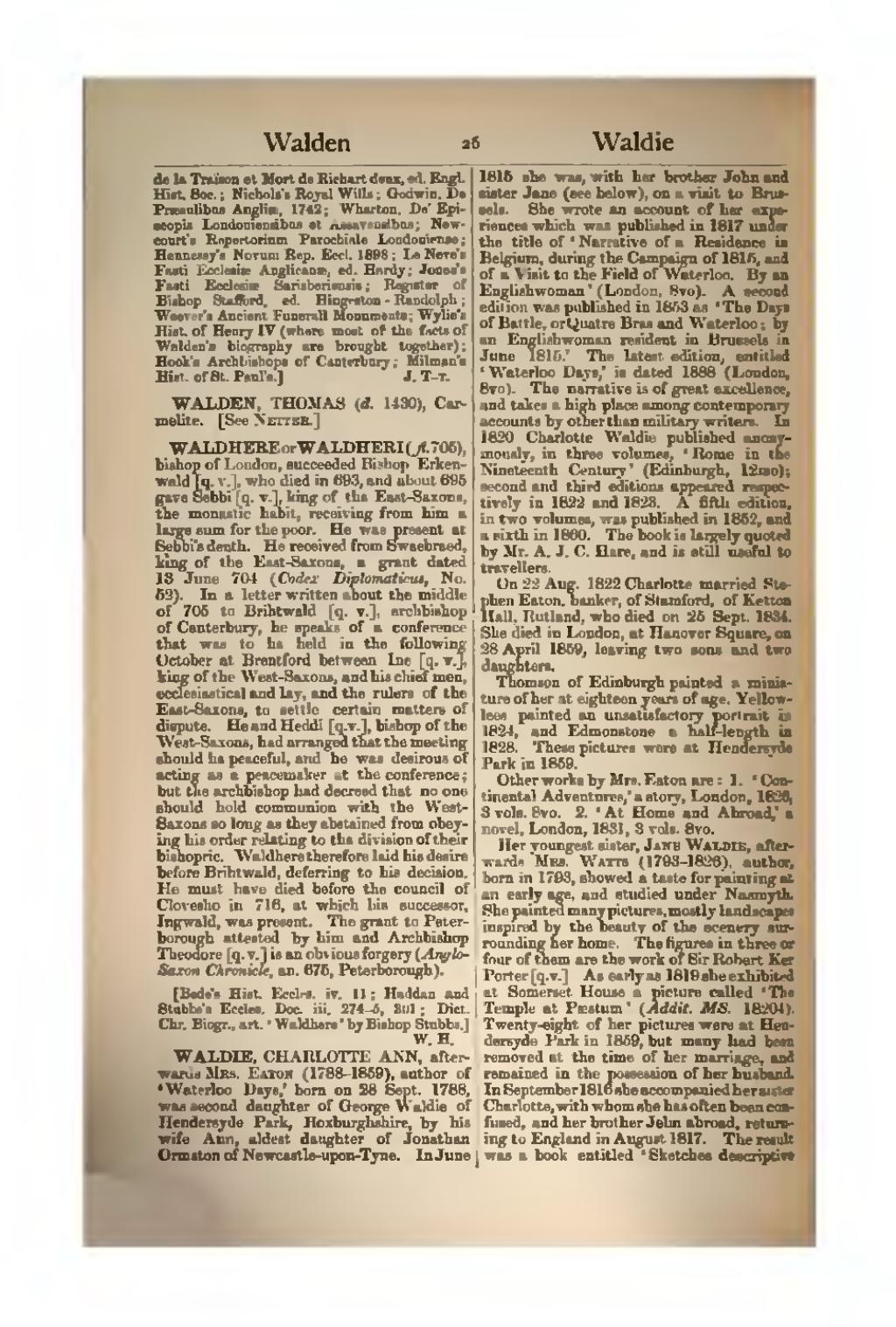WALDEN, THOMAS {d. 1430), Carmelite. [See Netter.]
WALDHERE or WALDHERI (fl. 705), bishop of London, succeeded Bishop Erkenwald [q. v.], who died in 693, and about 695 gave Sebbi [q. v.], king of the East-Saxons, the monastic habit, receiving from him a large sum for the poor. He was present at Sebbi's death. He received from Swaebraed, king of the East-Saxons, a grant dated 13 June 704 (Codex Diplomaticus, No. 52). In a letter written about the middle of 705 to Brihtwald [q. v.], archbishop of Canterbury, he speaks of a conference that was to be held in the following October at Brentford between Ine [q. v.], king of the West-Saxons, and his chief men, ecclesiastical and lay, and the rulers of the East-Saxons, to settle certain matters of dispute. He and Heddi [q. v.], bishop of the West-Saxons, had arranged that the meeting should be peaceful, and he was desirous of acting as a peacemaker at the conference; but the archbishop had decreed that no one should hold communion with the West-Saxons so long as they abstained from obeying his order relating to the division of their bishopric. Waldhere therefore laid his desire before Brihtwald, deferring to his decision. He must have died before the council of Clovesho in 716, at which his successor, Ingwald, was present. The grant to Peterborough attested by him and Archbishop Theodore [q. v.] is an obvious forgery (Anglo-Saxon Chronicle, an. 675, Peterborough).
[Bede's Hist. Eccles. iv. 11; Haddan and Stubbs's Eccles. Doc. iii. 274–5, 301; Dict. Chr. Biogr., art. ‘Waldhere’ by Bishop Stubbs.]
WALDIE, CHARLOTTE ANN, afterwards Mrs. Eaton (1788–1859), author of ‘Waterloo Days,’ born on 28 Sept. 1788, was second daughter of George Waldie of Hendersyde Park, Roxburghshire, by his wife Ann, eldest daughter of Jonathan Ormston of Newcastle-upon-Tyne. In June 1815 she was, with her brother John and sister Jane (see below), on a visit to Brussels. She wrote an account of her experiences which was published in 1817 under the title of ‘Narrative of a Residence in Belgium, during the Campaign of 1815, and of a Visit to the Field of Waterloo. By an Englishwoman’ (London, 8vo). A second edition was published in 1853 as ‘The Days of Battle, or Quatre Bras and Waterloo; by an Englishwoman resident in Brussels in June 1815.’ The latest edition, entitled ‘Waterloo Days,’ is dated 1888 (London, 8vo). The narrative is of great excellence, and takes a high place among contemporary accounts by other than military writers. In 1820 Charlotte Waldie published anonymously, in three volumes, ‘Rome in the Nineteenth Century’ (Edinburgh, 12mo); second and third editions appeared respectively in 1822 and 1823. A fifth edition, in two volumes, was published in 1852, and a sixth in 1860. The book is largely quoted by Mr. A. J. C. Hare, and is still useful to travellers.
On 22 Aug. 1822 Charlotte married Stephen Eaton, banker, of Stamford, of Ketton Hall, Rutland, who died on 25 Sept. 1834. She died in London, at Hanover Square, on 28 April 1859, leaving two sons and two daughters.
Thomson of Edinburgh painted a miniature of her at eighteen years of age. Yellowlees painted an unsatisfactory portrait in 1824, and Edmonstone a half-length in 1828. These pictures were at Hendersyde Park in 1859.
Other works by Mrs. Eaton are:
- ‘Continental Adventures,’ a story, London, 1826, 3 vols. 8vo.
- ‘At Home and Abroad,’ a novel, London, 1831, 3 vols. 8vo.
Her youngest sister, Jane Waldie, afterwards Mrs. Watts (1793–1826), author, born in 1793, showed a taste for painting at an early age, and studied under Nasmyth. She painted many pictures, mostly landscapes inspired by the beauty of the scenery surrounding her home. The figures in three or four of them are the work of Sir Robert Ker Porter [q. v.] As early as 1819 she exhibited at Somerset House a picture called ‘The Temple at Pæstum’ (Addit. MS. 18204). Twenty-eight of her pictures were at Hendersyde Park in 1859, but many had been removed at the time of her marriage, and remained in the possession of her husband. In September 1816 she accompanied her sister Charlotte, with whom she has often been confused, and her brother John abroad, returning to England in August 1817. The result was a book entitled ‘Sketches descriptive
